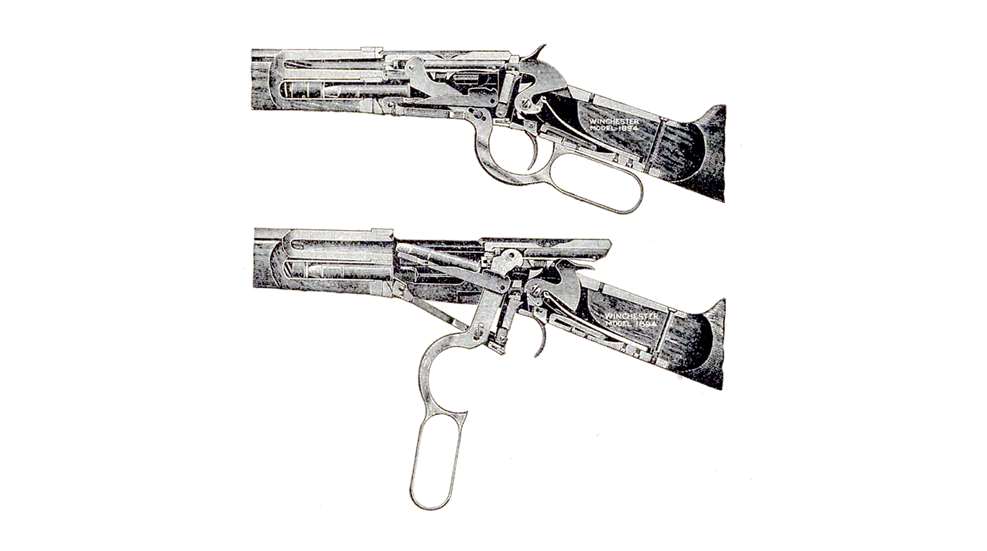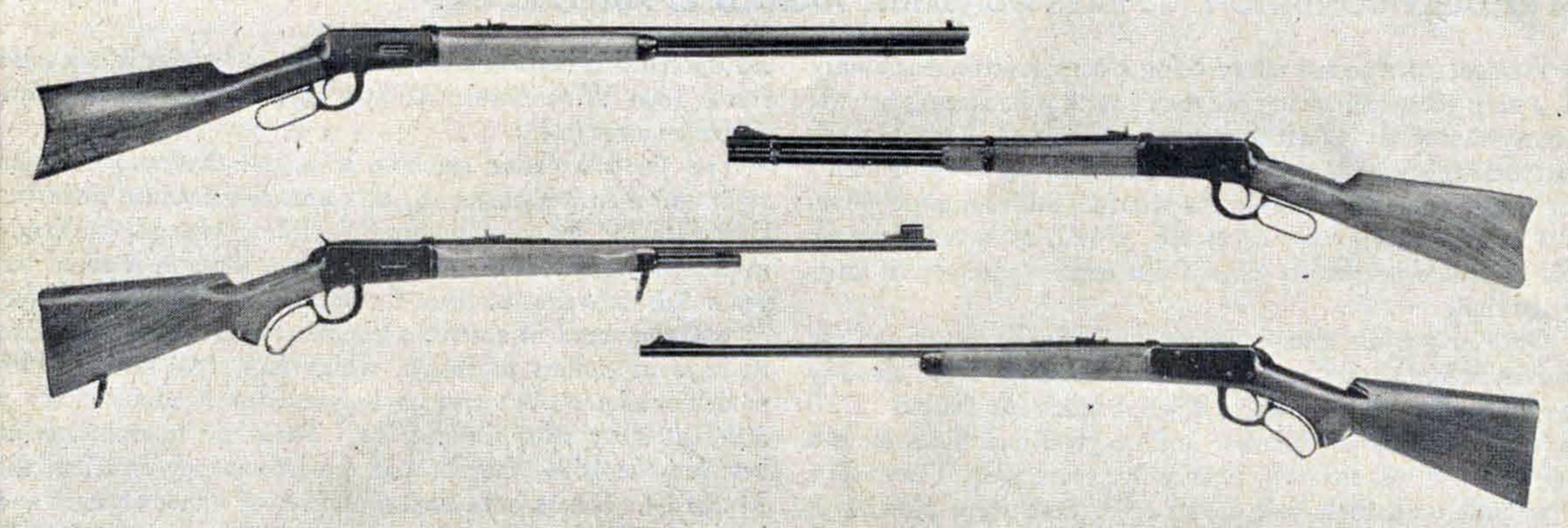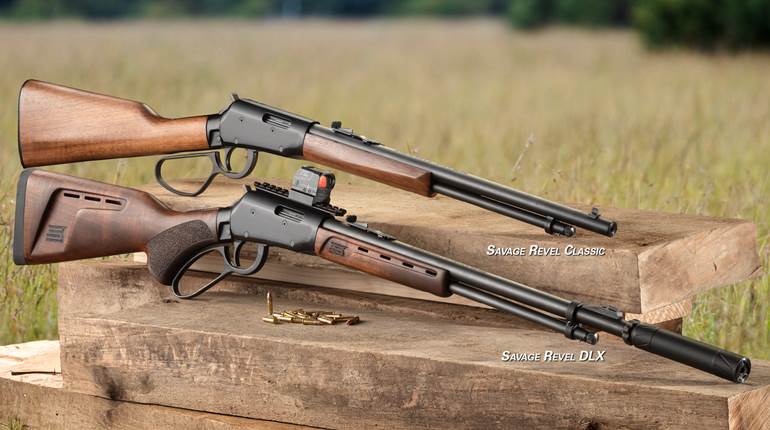
This article, "Modernizing The '94 Winchester" appeared originally in the January 1949 issue of The American Rifleman. To subscribe to the monthly magazine, visit NRA’s membership page.
Lest someone accuse me of being a conservative reactionary or a tobacco-chewing old timer with a hankering for the 'thutty-thutty' days (which might be accurate), I want to say that I usually tote a modern bolt gun with the latest in hunting scopes when rambling in the woods. Such an outfit offers real sport. It is gratifying to me, as well as amazing to my less fortunate neighbors, when I can make a spectacular long-range shot.
Once in a while though, when the larder is empty and the wolves of hunger are yapping close to the door, I get blood in my eye and go out for meat. Then, I reach for the old .30-30 carbine. I know it's obsolete and no good and the shell is a has-been. It was that way twenty-five years ago. The experts who hunt with their feet on an office desk were plowing it under when I learned to read. The .30-30 will scatter all over a couple of inches at fifty yards, I realize, and trajectory and sight setting can't be figured beyond a hundred and fifty yards. The action is weak and springy, with the locking lugs on the back of the bolt. But, for some reason, deer die just as dead whether they are hit in the center or on the edge of the heart with it; too, most deer in timber country are killed within fifty yards.
The point that interests me is the speed of handling of the little carbine. By the time a deer makes two jumps, I can perforate his hide with it. It takes a little more time for me to get the modern bolt creation lined on him. And in the brushy country of Minnesota, where I live, if a deer makes three jumps, he is behind a balsam playing hide and seek.
Weak and springy though the .30-30 is, the action never seems to blow up. Some I've seen with the .30-30 barrel worn out, then the chamber reamed a little with a round file or a drill bit until a .32 Special cartridge could be crowded in. They shot right well for a while. Of course pressures were terrific in the tight barrel and the locking bolt gradually set back until there was plenty of headspace, but nothing blew. I don't suggest the .30-30 be rechambered so, but it is done.
Why .30-30 and not .32 Special? A .32 Special is a transition caliber as I see it, a makeshift, something for which there is no logical excuse now. At the beginning of the smokeless powder era, the old .32-40 with its straight shell wouldn't burn smokeless powder efficiently. So, someone reamed out the .32-40 chamber a little to bottleneck it and, presto, they had a smokeless powder gun. The old black powder 1.6-inch twist is still in the barrel. Contrary to popular belief, the increase in killing power of the .32 Special over .30-30 is infinitesimal, nor does the gun have a good barrel. The old .30-30 can be shot at game as long as anything resembling rifling can be seen in it, but get a little wear or a few pits in the .32 Special and it will shoot all over grand pappy's barn.
The problem is to obtain a .30-30 carbine these days. If the hardware dealer is handed $24.00 and told to get one, he will ask for sixty dollars and say to wait until somebody gets one made. But there is an answer. Look in the attic or in a neighbor's garage, behind the junk car parts, and you are apt to find something that looks like a .30-30, only it might be about a yard and half long and say .38-55 on the side. Of course, it could be an old long .30-30, a .25-35, a .32-40, or a .32 Special. It makes no difference just so long as it is a solid frame J 89+ Winchester. All you have to do is make a few simple changes in it.
The '94 is a classic example of a gun that was designed right and then left alone. Some companies produce little but headaches for the poor gunsmith-trifling changes are made in models every year or so. Then when the gun is about ten years old, he writes to them for some parts. Nine times out of ten, they send in answer a printed form, which they seem to have in endless profusion, which says, "So sorry. This model obsolete. We can no longer furnish parts." It's a different story with the old '94. Parts are interchangeable between the 1894, the 55, and the late snappy creation, the Model 64. There have been a number of minor changes and improvements, but always in such a way that new parts could be substituted for old without a lot of filing and fitting. I'm not saying that the new Model 6+ is the same as the old '94- it isn't by a long shot. The Model 64 is streamlined and modernized, and has modern heat-treated steel in it. But just the same, Model 64 parts fit the '94.
 Four Winchester rifle models, produced over a half-century, are variations of the model '94 rifle (at top), which was made in calibers .32-40, .38-55, ,30-30, 25-35, and .32 Special. The parts of the 94 are interchangeable with parts of the other three guns shown here, the model 94 carbine (second from top), model 55 (second from bottom), and model 64 (bottom). The model 64 is still being produced in three calibers, .30-30, .25-35, and .32 Special.
Four Winchester rifle models, produced over a half-century, are variations of the model '94 rifle (at top), which was made in calibers .32-40, .38-55, ,30-30, 25-35, and .32 Special. The parts of the 94 are interchangeable with parts of the other three guns shown here, the model 94 carbine (second from top), model 55 (second from bottom), and model 64 (bottom). The model 64 is still being produced in three calibers, .30-30, .25-35, and .32 Special.
To get down to cases: we have one of the old long guns and we want to modernize it. First, send to Winchester for a .30 caliber WCF barrel, 20 inch, Model 64, and a number 22K rear sight with 3C elevator. Specify U-notch; otherwise they are apt to send the V-style which doesn't work so well with a front bead. A number 57 Marble's front sight is the right height to work with the 22K rear. A new wooden fore-end and a fore-end tip can be ordered and the new wood will close some unsightly cracks between the barrel and the wood fore-end, but it will make no difference in the shooting.
Some grief can be saved by ordering a pair of .30 WCF cartridge guides at the same time. Be sure to get the screws with them because the old ones will undoubtedly be spoiled 111 taking them out. On some old '94's the cartridge guides have a universal shape, feeding various calibers with equal facility. On others, they will feed only the cartridge meant for the gun. Any of them can be worked out with a file to make them work but it takes a little practice. The .25-35 and .32-40 guides can be widened for the bottleneck cartridge with a flat file. When converting from .38-55, it is quite often necessary to use an 8-inch round file on the portion of the guide the cartridge rim feeds through. The groove must be deepened slightly and angled forward at the top, necessary because of the angle at which the cartridge rides the carrier. If a short magazine like that of the Model 64 is desired, a new magazine plug should be obtained, but the magazine can be used full 20-inch length with the old plug.
To tear down the old gun, remove the magazine plug screw, punch out the magazine ring pin, and draw out the magazine tube. Take out forearm-tip screws, remove forearm tip and forearm. Then knock out forearm-tip tenon, punching from left to right. The old barrel can then be gripped in the vise because it isn't any good anyway. Pad the jaws of a large monkey wrench with copper and grip the receiver as far forward as possible. If the wrench is placed in the middle of the receiver, the receiver might be sprung. Open the finger lever and reef on the wrench. The barrel has a right-hand thread and usually can be turned out quite easily. If the finger lever isn't opened, it is just too bad. The extractor will get twisted awry and the breech bolt will go where good things don't go. Once in a while, the barrel is in quite solid and it is necessary to heat the receiver ring slightly. In extreme cases it is necessary to tap the ring with a hammer, being careful not to mar it since it is quite soft. The magazine ring is still on the old barrel but the ends of it are cut on a radius, so stick one end of the magazine tube in and swing radially. The magazine ring will fall right out.
Clean and oil the threads on the new barrel and it is ready to screw into place. This time, it is necessary to grip it without marring it. I use a clamp made of two iron plates measuring 4 x 7 x ¾ inches. Drill a 1-inch hole in each corner of one plate and corresponding 1 1/8-inch holes in the other plate. Place 1 x 5-inch cap screws in the 1-inch holes and weld the heads in place. Groove a pair of 1-inch hardwood blocks to fit the barrel just forward of the threads. Sprinkle powdered rosin in the grooves, place the barrel in the grooves and between the plates, and screw the nuts as tight as you can get them. If the rosined blocks ever slip on the barrel, the blueing will come off.
The clamp can be gripped in the vise and the barrel screwed into place just as the old one was removed. Use the extractor cut for an index mark to align it. The barrels are standardized and held to close tolerances and can usually be fitted to within proper headspace limits. Headspace trouble is not as serious with a rimmed cartridge and the breech pressure is low with the .30-30 anyway. If there is excessive clearance between the breechblock and the cartridge, it can only mean that the breech block or the locking bolt is worn and must be rec placed. There is no other way to take up .30-30 actions. The barrel could be seated one thread deeper but doing so would set the breech block back and prevent it from aligning with the take-apart hole in the side of the receiver. Th us, the action couldn't be taken down for repairs without first removing the barrel. If the magazine is to be full length, cut exactly six inches from the receiver end of it. Cut 1/8-inch from the tip of the magazine plug screw since it can't be screwed into the new barrel. Pass a drill through the pin hole in the magazine ring, making sure that the magazine tube is as far back as it will go. This will cut a groove in the tube so that the pin will hold it in place. Assemble everything as before.
The old cartridge guides may feed all right but if they jam the cartridges, replace them or file them out. Removing the guides is a little tricky. Right-angle screwdrivers can be made from small Allen safety set-screw wrenches to get at the screws. However, the left guide screw can be got at by removing the loading port spring cover. Then, using a long skinny screwdriver to go through the left screw hole, get at the right one. In replacing the guides, make sure they and their receiver grooves are clean and the guides pulled up tightly or the gun will jam.
Everything is now ready to tryout the gun. The shooter who must shoot minute-of-angle groups, and speed up his bullets so fast they melt the lead cores and disintegrate all over the landscape before they get to the target, won't find much appeal in this outfit. But if he is a run-of-the-mill meat-hunter like most of us, he'll have a nice little gun.
—Harold E. Macfarland





































